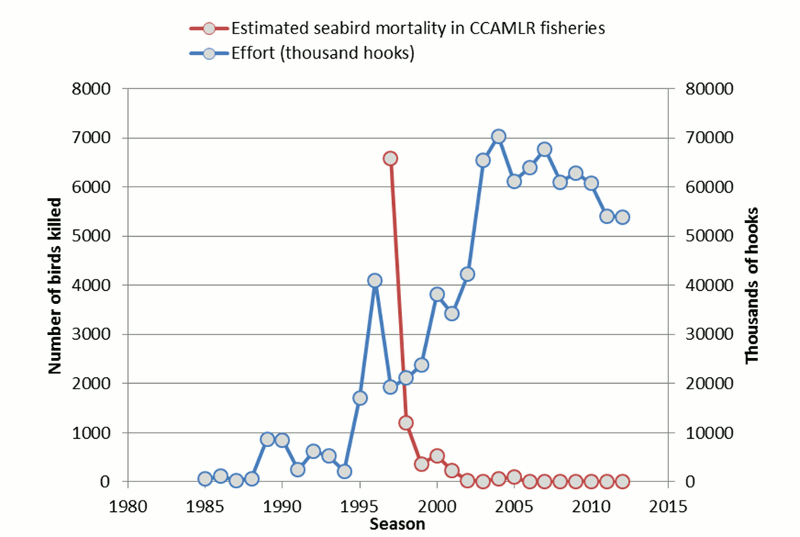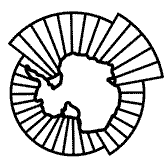The CAMLR Convention provides the foundation for marine resource conservation in the Southern Ocean. During its history of just over thirty years, CCAMLR has set global benchmarks for operationalising an ecosystem approach to support the sustainable use of marine living resources.
Achievements have been based on:
- recognised international best practice at-sea scientific observer program
- management decisions that take account of the impact on the ecosystem and the sustainability of fished resources
- rigorous scientific processes developed to support consideration of marine protected areas in the Convention Area
- a combination of surveillance, enforcements and market controls.
Specific achievements include:
- addressing the challenge of illegal, unreported and unregulated (IUU) fishing
- establishing Marine Protected Areas (MPAs) in the Southern Ocean
- reducing seabird mortality
- establishing the CCAMLR Ecosystem Monitoring Program (CEMP)
- managing Vulnerable Marine Ecosystems (VMEs)
Addressing the challenge of illegal, unreported and unregulated (IUU) fishing
IUU fishing for toothfish was first identified in the Convention Area in the early 1990s and sparked considerable concern for the Commission. In response, the Commission adopted and implemented a range of measures to detect, deter and eliminate IUU fishing. As a result of these measures, IUU fishing in the Convention Area has declined and moved from Members' EEZs to the high seas.
There remains considerable uncertainty about the extent of IUU fishing in the Convention Area. Information suggests that up to seven IUU vessels remain active in the Convention Area. There is some evidence to suggest that these vessels are supported by a reefer vessel and cooperate with each other. Ongoing concerns relating to IUU fishing include the absence of verifiable information on fishing operations, the lack of detailed information concerning removals by IUU vessels and the impact of IUU operations on species taken incidentally including on vulnerable marine ecosystems. CCAMLR Members continue to work actively to eliminate IUU fishing from the Convention Area.
Establishing Marine Protected Areas (MPAs) in the Southern Ocean
An MPA is a marine area that provides protection for all or part of the natural resources therein. It aims to provide protection to marine species, biodiversity, habitat, foraging and nursing grounds, and in some cases to preserve historical and cultural sites. MPAs can assist in conserving ecosystem processes and sustaining biological productivity. CCAMLR uses MPAs to complement other management tools including catch limits, gear restrictions, and closures.
In 2009, CCAMLR established the world’s first high seas MPA, the South Orkney Islands Southern Shelf Marine Protected Area, a region covering 94 000 km2 in the southern Atlantic Ocean. This is the first step towards establishing a representative system of MPAs in the Convention Area and further MPAs are envisaged as part of the General framework for the establishment of CCAMLR Marine Protected Areas (Mesure de conservation 91-04).
At the 35th annual meeting of the Commission in 2016, Members agreed to establish a new MPA in the Ross Sea. This 2.09 million km2 area of the Ross Sea will become the world’s largest MPA once it enters into force on 1 December 2017, according to Mesure de conservation 91-05.
The Ross Sea region contains features of exceptional ecological value and scientific importance and the Ross Sea shelf is one of the most productive areas of the Southern Ocean and one of the few places in the world that still has its full community of top-level predators. Furthermore, the Ross Sea region is among the best studied areas of high-latitude, continental shelf ocean in the Southern Hemisphere, with unique time-series data describing the region’s geological, oceanographic, climatic and ecological history, which offer rich opportunities for the study of climate change effects in the region.
This MPA will include a 'no-take' zone (72% of the total area) which forbids all fishing. Other sections of the MPA will permit some harvesting of fish and krill for scientific research which will, among other objectives, be targeted to the monitoring of changes in the ecosystem that may be ascribed to fishing, climate change, or both.
Reducing seabird mortality
Over the past 15 years, seabird mortality arising from fishing operations has been reduced from thousands of birds annually to almost zero in fisheries regulated by CCAMLR. This has been achieved through the implementation of a combination of measures including seasonal closures, night setting, the deployment of streamer lines, additional line weights to increase sink rates, prohibition on the discharge of offal during setting and hauling and the use of bird exclusion devices around the hauling point.
While the reduction of seabird mortality in the CCAMLR Convention Area is exceptional, seabird populations remain at risk in the Southern Ocean because fishing operations in waters north of the CCAMLR Convention Area are not required to employ the same suite of measures that would achieve similar levels of protection for non-target species.
Mitigating incidental catches of seabirds – Effective implementation of science and policy (David Ramm, 2013)

Establishing the CCAMLR Ecosystem Monitoring Program (CEMP)
CCAMLR's ‘ecosystem approach’ to managing the commercial harvesting of Antarctic marine living resources goes beyond monitoring the effects of fishing on harvested species (target species) to monitoring dependent species and associated species for potential impacts.
Dependent species are those species that feed on the target species or are impacted by the removal of the target species from the food web. Associated species are typically those that are impacted directly by the action of fishing e.g. through by-catch or incidental mortality.
In order to provide this information CCAMLR set up the CCAMLR Ecosystem Monitoring Program (CEMP) in 1989. The two aims of CEMP are to:
- detect and record significant changes in critical components of the marine ecosystem within the Convention Area, to serve as a basis for the conservation of Antarctic marine living resources
- distinguish between changes due to harvesting of commercial species and changes due to environmental variability, both physical and biological.
CEMP sites can be viewed on a map of Antarctica and the Southern Ocean via CCAMLR's Missing Link #82341.
Managing Vulnerable Marine Ecosystems (VMEs)
The identification of adverse impacts and threats to VMEs (including seamounts, hydrothermal vents, cold water corals and sponge fields) resulted in a call for global action to regulate bottom fishing on the high seas. Responding to this call, CCAMLR developed methods for identifying VMEs and encounter protocols for fishing vessels. A range of conservation measures have been put in place by CCAMLR to address the protection of VMEs:
- restrictions on the use of bottom trawling gear in high-seas areas of the Convention Area
- bottom fishing in the Convention Area
- interim measure for bottom fishing activities subject to Conservation Measure 22-06 encountering potential vulnerable marine ecosystems in the Convention Area
- protection of registered vulnerable marine ecosystems in subareas, divisions, small-scale research units, or management areas open to bottom fishing
Adherence to these conservation measures is monitored via the Scientific Observer Program with ongoing evaluation by the Standing Committee on Implementation and Compliance (SCIC).


